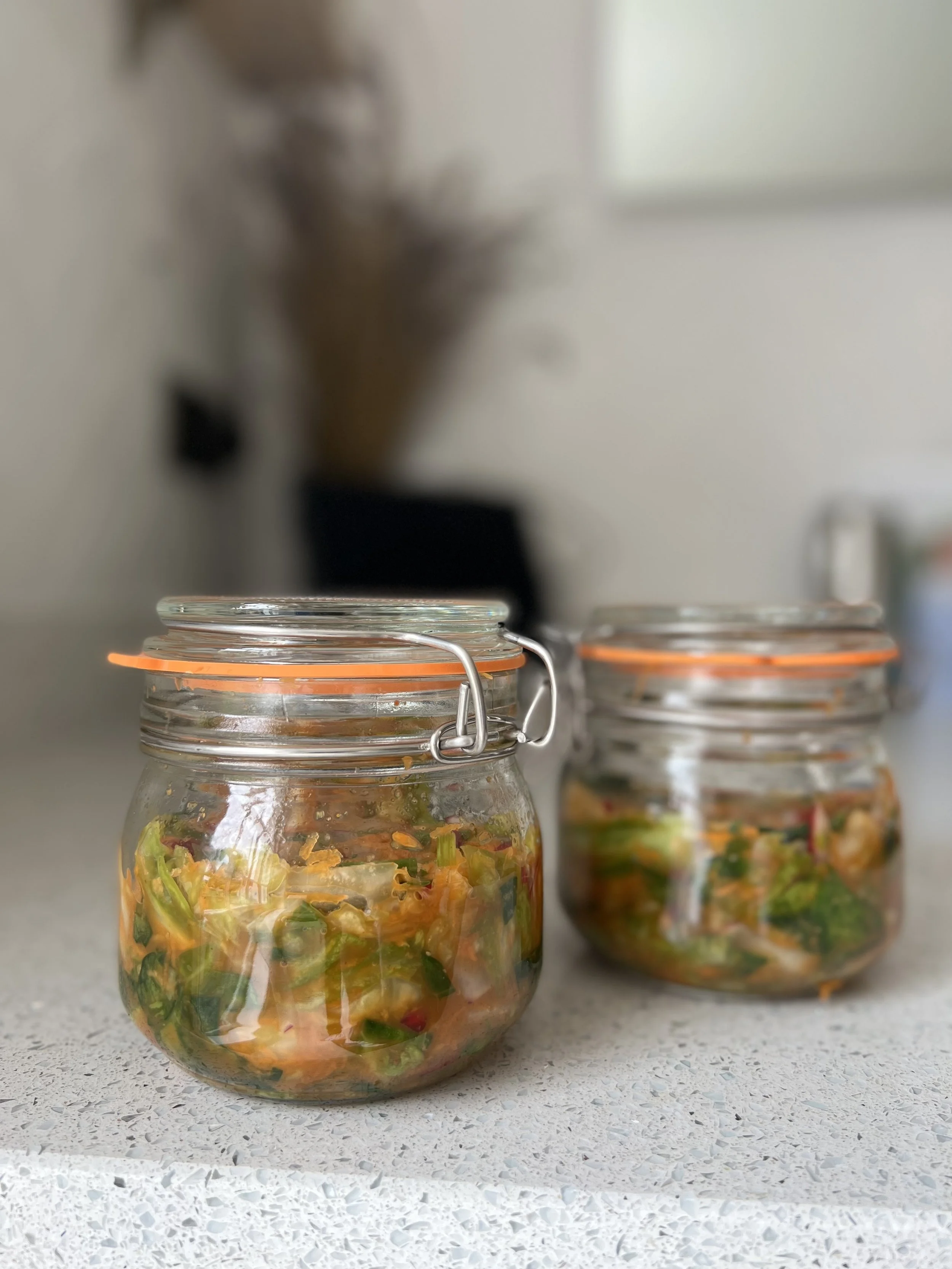GUIDE TO MAKING KIMCHI
Kimchi is a traditional Korean dish made from fermented vegetables, most commonly napa cabbage and Korean radishes. This tangy and spicy delicacy is not only a flavorful addition to meals but also a powerhouse of nutrition. The fermentation process in kimchi promotes the growth of beneficial probiotics, which are known to improve gut health. These probiotics aid in digestion, enhance the immune system, and can even contribute to better mental health. Incorporating kimchi into your diet can be a delicious way to support your overall well-being.
Kimchi Recipe
Equipment
500ml glass jar with lid (e.g. Kilner 0.5 Litre Round Clip Top Jar)
1 small ramekin
1 large mixing bowl
1 small mixing bowl
Optional: gloves (for mixing)
Ingredients (Serves 8, 40g portions)
Base:
200g Cabbage*
500ml filtered water
25g sea salt
*Kimchi is traditionally made with napa cabbage, but any cabbage will work (depending on what you fancy/what’s available in the shops), e.g., Chinese cabbage, green cabbage, savoy cabbage, white cabbage, red cabbage, or bok choy.
Toppers:
1 carrot (50g), grated
1 spring onion, diced
50g radish, chopped into matchsticks
1 garlic clove, finely sliced
1 tsp ginger, grated
1/2 tsp chilli powder
1/2 tsp paprika
1.5 tbsp soy sauce (or tamari if gluten-free)
Method
Prepare the Cabbage:
Cut the cabbage in half and remove the hard core. Separate the leaves and rinse under water to ensure any residue soil is removed. Thinly slice the cabbage.
Salt the Cabbage:
Put the cabbage and salt in a bowl. Firmly massage the salt into the cabbage. Pour the filtered water over the cabbage and submerge it by sitting a plate on top. Leave for 2 hours.
Rinse and Prepare Vegetables:
Drain the cabbage and thoroughly rinse to remove excess salt. Squeeze water out of cabbage and add to a large mixing bowl. Add the grated carrot, diced spring onions, and chopped radish.
Make the Paste:
In a smaller bowl, make a paste with the garlic, ginger, chili powder, paprika, and soy sauce. Mix until well combined.
Combine and Massage:
Add the paste into the larger bowl and use your hands to thoroughly massage it into the mixture. Continue to massage until the mixture begins releasing juices.
Pack the Jar:
Place the mixture into the jar, pushing it down with the end of a rolling pin, so there is a layer of juice separating the kimchi and the air above. Place a small ramekin dish on top of the mixture and fill it with water to ensure the vegetables stay submerged.
Ferment:
Secure the lid and leave at room temperature (ideally, 18–22°C), out of direct sunlight. Each day, check on your kimchi and release any gas that has built up by gently opening the jar to let it out.
Taste Test:
Taste test after 3 days. The kimchi is ready when it tastes slightly sour, and the cabbage has softened. You can leave it for another 1-2 days if it needs longer.
Store:
When it’s ready, pop it in the fridge. Refrigeration will pause the fermentation process, and your kimchi will stay fresh for several weeks or months.
Serving Suggestions
Kimchi on crackers with feta and black pepper
Side Dish: Serve kimchi as a side dish with rice, noodles, or as part of a buddha bowl.
Topping: Use kimchi as a topping for burgers, savoury pancakes, or tacos to introduce a unique flavor and texture.
Soup and Stews: Add kimchi to soups and stews for an extra layer of flavour and nutrition.
Salads: Incorporate kimchi into salads for a spicy, fermented twist.
Snacks: Enjoy on crackers with some crumbled feta as a snack or light lunch.
Sandwiches and Wraps: Include kimchi in sandwiches and wraps for a zesty, crunchy element.
Enjoy your homemade kimchi and reap the gut health benefits with every bite!




